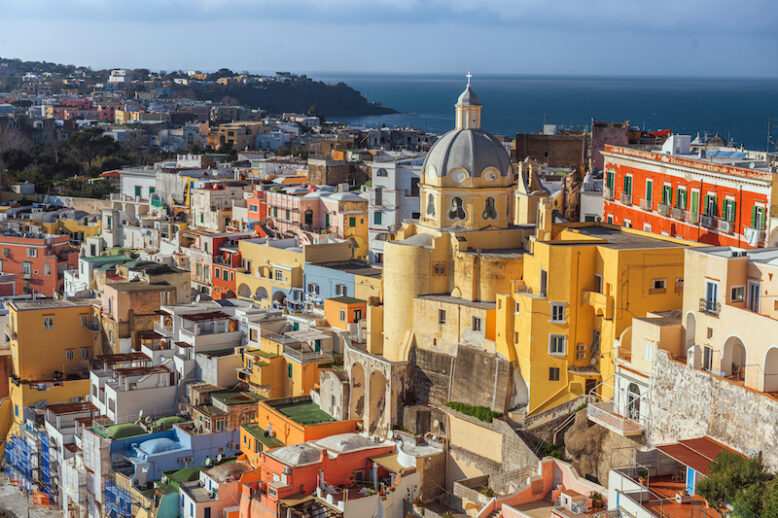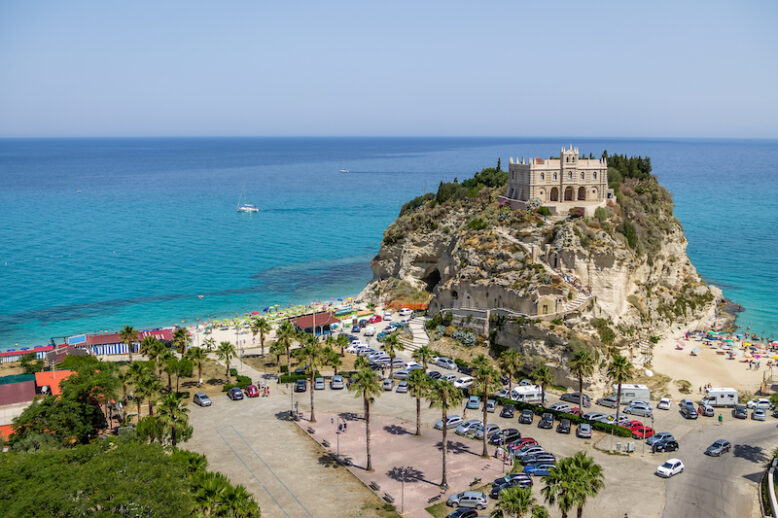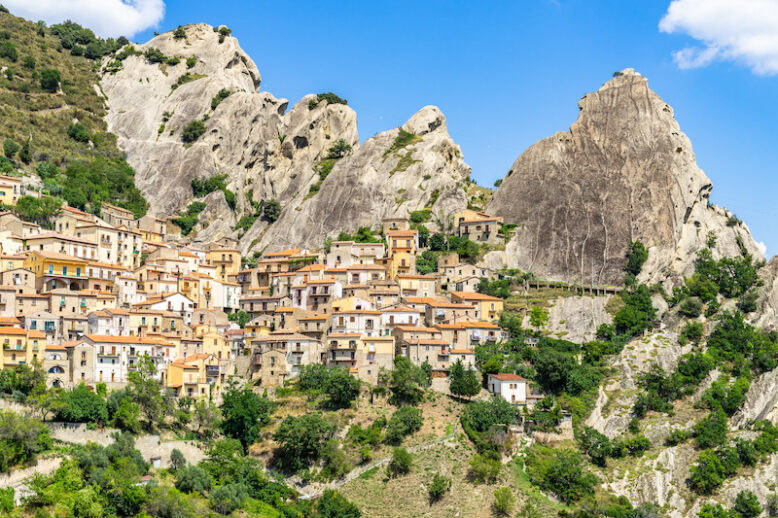Viaggio nel sud Italia: 8 luoghi unici da visitare
Spoiler: you won’t find the usual tourist hotspots like Naples or Alberobello here. Tons of travel guides and articles have already covered these destinations extensively, so I prefer to shine a spotlight on the hidden gems of southern Italy travel.
Spoiler: qui non troverete le solite mete turistiche come Napoli o Alberobello, già ampiamente trattate in molte guide e articoli di viaggio. Invece, mi concentrerò su quei tesori nascosti che rendono unico un viaggio nel Sud Italia.
This part of Italy, much like the rest of the country, boasts a plethora of incredible places waiting to be explored: historic sites, picturesque villages straight out of a postcard, turquoise waters, and centuries-old traditions. Honestly, I could easily compile an epic encyclopedia detailing every beautiful spot in the south. But to keep this article concise – and your patience intact – I’ll provide you with just a glimpse of the treasures you can find here.
Questa parte dell’Italia, così come il resto del paese, offre una ricchezza di luoghi straordinari da esplorare: siti storici, borghi pittoreschi, acque turchesi, e tradizioni secolari. Potrei scrivere un’enciclopedia dettagliando tutti i magnifici luoghi del Sud Italia, ma per mantenere questo articolo breve (e conservare la vostra pazienza!), mi limiterò a fornire solo un assaggio delle meraviglie che potrete scoprire.
So, let’s embark on an exploration of some of the most unique places in southern Italy… I have the feeling your travel wish list is about to get a major upgrade!
Pronti per esplorare alcuni dei luoghi più meravigliosi del Sud Italia? Ho la sensazione che la vostra lista di viaggio stia per allungarsi parecchio!
Majella park, where nature and spirituality converge
Il Parco della Majella, dove natura e spiritualità convergono
The Majella Park in Abruzzo is one of the green lungs of southern Italy, reaching over 2700 meters at its highest peak. Its close proximity to the sea has created a dynamic environment characterized by diverse microclimates and ecosystems. The result? An extraordinary level of biodiversity that earned Majella the prestigious UNESCO Geopark status.
Il Parco della Majella in Abruzzo è uno dei polmoni verdi del sud Italia e raggiunge un’altitudine di oltre 2700 metri nella sua vetta più alta. La sua vicinanza al mare ha contribuito a creare un ambiente dinamico caratterizzato da microclimi ed ecosistemi diversificati. Il risultato? Una straordinaria biodiversità che ha conferito a questo sito il prestigioso status di Geoparco UNESCO.
Nestled within the park are picturesque villages, each with its own unique charm. Pretoro, for instance, boasts a recovery center for the Apennine wolves, while Pacentro is home to one of the best-preserved fortifications in Abruzzo. And don’t miss Pennapiedimonte, known as the balcony of Abruzzo, offering views that stretch all the way to the coast. Bonus: there’s a rocky spur that looks like a seated woman believed to be the goddess Maja, whose story intertwines with these places and has given the park its name.
All’interno del parco si possono scoprire pittoreschi villaggi, ognuno con un fascino unico. Pretoro, per esempio, ospita un centro di recupero per i lupi appenninici, mentre Pacentro vanta una delle fortificazioni meglio conservate dell’Abruzzo. Da non perdere anche Pennapiedimonte, il balcone dell’Abruzzo, che offre una splendida vista fino alla costa e presenta uno sperone roccioso che ricorda una figura femminile seduta, identificata come Maja. La storia di questa dea, infatti, si intreccia con questi luoghi e ha ispirato il nome del parco.
Scattered throughout these mountains are ancient hermitages literally carved into the rock. Back in the day, these spots were used for hermitic living and meditation. These days, visiting them them is like taking a glimpse into an ancient way of connecting with spirituality amidst the wilderness. Some of these gems include the Eremo Santo Spirito Hermitage in Majella and the Eremo di San Bartolomeo in Legio. The latter even has a little spring known for its miraculous properties!
Tra le montagne del parco si trovano antichi eremi scolpiti nella roccia, che un tempo erano destinati alla vita eremitica e alla meditazione. La visita a questi luoghi offre oggi uno sguardo affascinante su un antico modo di connettersi con la spiritualità immersi nella natura selvaggia. Tra gli eremi più suggestivi spiccano l’Eremo Santo Spirito nella Majella e l’Eremo di San Bartolomeo a Legio, quest’ultimo famoso anche per una piccola sorgente dalle proprietà miracolose.
The idyllic island of Procida
L’idilliaca isola di Procida
Procida is an adorable slice of sunshine, waves, and natural beauty just off the Naples coast. While everyone’s gushing over the glam of Capri and Ischia, Procida offers a more intimate atmosphere, allowing you to experience the authentic essence of southern Italian island living.
Procida è un adorabile angolo di sole, mare e natura al largo della costa di Napoli. Mentre spesso ci si limita ad esaltare il fascino di Capri e Ischia, Procida offre un’esperienza più intima, permettendo di immergervi nell’autentico spirito isolano del sud Italia.
Whether you’re exploring the Marina Corricella, where cute, pastel-hued houses cascade down to the water’s edge, or soaking in the beautiful panoramic views from Terra Murata, the island’s highest point, Procida’s beauty is both distinctive and down-to-earth. This charm already caught the eye of ancient Romans, who frequently chose Procida as their vacation destination.
Sia che stiate esplorando Marina Corricella, dove graziose case dai colori pastello si susseguono fino al bordo dell’acqua, o ammirando la spettacolare vista da Terra Murata, il punto più alto dell’isola, potrete cogliere la bellezza distintiva e autentica di Procida. Un fascino unico che aveva già conquistato gli antichi Romani, molti dei quali sceglievano proprio quest’isola come meta per le loro vacanze.
Spanning a mere 4 km, the entire island is a treasure trove of photogenic charm. Wandering through its quaint streets feels like stepping onto a movie set, with laundry swaying in the breeze and lemon trees peering out from behind tall walls that hide secret gardens. What adds to Procida’s allure is its starring role in cinematic classics like “The Talented Mr. Ripley” and “The Postman.”
L’isola è molto piccola – 4 km super fotogenici! Passeggiare per le sue graziose strade offre la sensazione di essere catapultati in un set cinematografico, con il bucato steso al vento e i limoni che spuntano da giardini segreti nascosti da alti muri. Di fronte a tanta bellezza, non stupisce che Procida abbia fatto da sfondo a capolavori cinematografici come “Il talento di Mr. Ripley” e “Il postino”.
Sure, you can squeeze in a day trip from Naples to catch the highlights, but honestly, I’d recommend staying a couple of days. That way, you really soak in the laid-back vibes and simple beauty of Procida.
Sebbene sia possibile fare una gita di un giorno da Napoli per ammirare i luoghi più suggestivi dell’isola, io vi consiglio di dedicare almeno un paio di giorni a Procida. Solo così potrete assaporare appieno il relax e la bellezza semplice che questa affascinante isola ha da offrire.


Sepino, Molise’s ancient Roman town
Sepino, l’antica città romana del Molise
Located in the unspoiled region of Molise, Sepino is another jewel of Southern Italy travel that few people are familiar with. While Pompeii often takes center stage when it comes to Roman cities in Italy, Sepino is like a time capsule with its amazingly well-preserved structures, making it a fantastic archaeological site to explore.
Situato nella suggestiva regione del Molise, Sepino è un altro gioiello poco conosciuto che merita di essere scoperto durante un viaggio nel sud Italia. Mentre Pompei monopolizza l’attenzione quando si parla di città romane in Italia, Sepino offre un’esperienza unica grazie ad una struttura straordinariamente ben conservate che ne fa un eccezionale sito archeologico da esplorare.
Sepino’s origins can be traced back to the 4th century when the Samnites first established the settlement of Terravecchia, perched at 950 meters above sea level. But here’s the plot twist – the Romans conquered the site in 293 B.C. and moved the village downstream, at a crucial junction along two tratturi (ancient cattle tracks), which made trade and moving livestock way more efficient.
Le origini di Sepino risalgono al IV secolo, quando i Sanniti fondarono l’insediamento di Terravecchia a 950 metri sul livello del mare. Successivamente, i Romani conquistarono il sito nel 293 a.C., spostando il villaggio a valle, in un punto cruciale lungo due tratturi che facilitava il commercio e lo spostamento del bestiame.
Fast forward to today, and Sepino offers a captivating journey through ancient Rome. Picture this: intact walls, four entrance gates, and two main streets – the cardo and the decumanus – sprinkled with tangible remnants of daily life back then. These include a grand Basilica, thermal facilities and a theater that could accommodate up to 3,000 people. There’s even a water mill, one of Italy’s oldest.
Oggi, Sepino offre un affascinante viaggio nella storia. Troverete mura intatte, quattro porte d’ingresso e due strade principali, il cardo e il decumano, con resti della vita quotidiana di quell’epoca. Tra questi, spiccano una maestosa Basilica, strutture termali e un teatro in grado di ospitare fino a 3.000 spettatori. Non manca nemmeno un mulino ad acqua, tra i più antichi d’Italia.
Piscinas’ towering sand peaks
Le imponenti dune sabbiose di Piscinas
Piscinas Dunes present a landscape of extraordinary natural beauty on the enchanting island of Sardinia. Located near Arbus, about 80 km from Cagliari, this wild beach spans about 5 square kilometers and features golden sand dunes towering up to 100 meters – some of the tallest in Europe. Picture it as as a little slice of desert paradise with a sea breeze – no wonder it earned the title of UNESCO World Heritage Site!
Le Dune di Piscinas rappresentano un paesaggio naturale dirada bellezza nella splendida Sardegna. Ci troviamo nei pressi di Arbus, a circa 80 km da Cagliari, in una spiaggia selvaggia che si estende per circa 5 chilometri quadrati e vanta dune di sabbia dorata che raggiungono fino a 100 metri di altezza, classificandosi tra le più elevate d’Europa. Questo luogo straordinario è stato insignito del prestigioso titolo di Patrimonio dell’Umanità UNESCO e basta immaginare un piccolo paradiso desertico accarezzato dalla brezza marina per comprenderne il motivo di tale riconoscimento.
The best part? Hardly any crowds, making it the ultimate spot for a chill escape. Plus, there’s a naturist section for those seeking an all-over tan! Just a heads up, though – the waves can be a bit intense, so better to leave the rough sea to expert surfers.
Ciò che rende questo sito ancor più speciale è la sua atmosfera rilassata, lontana dalle folle di turisti, rendendolo il luogo ideale per chi cerca tranquillità. Senza contare che offre una sezione naturista per chi desidera godere del sole in totale libertà! Unico avvertimento: le onde possono risultare piuttosto intense, quindi fate attenzione e lasciate il mare agitato ai surfisti esperti.
As you make your way to the dunes, you’ll stumble upon the ghost village of Ingurtosu, providing a fascinating glimpse into the region’s mining history. And if you plan your visit in June and July, you might see the Caretta Caretta sea turtles laying their eggs, a true spectacle of nature.
Lungo il percorso che conduce alle dune, vi imbatterete anche nel suggestivo villaggio fantasma di Ingurtosu, che vi permetterà di esplorare la ricca storia mineraria della regione. Inoltre, programmando la vostra visita tra giugno e luglio, potreste avere l’opportunità di assistere a uno spettacolo straordinario: la deposizione delle uova da parte delle tartarughe marine Caretta Caretta.
Unveiling history’s first bikini at Villa Romana del Casale
Il primo bikini della storia alla Villa Romana del Casale
About 35 km from Caltagirone, right in the heart of Sicily, there’s this extraordinary luxury Roman villa from the 4th century AD just waiting to be explored. Rumor has it, it once belonged to a Roman senator, who had it decorated it with a mesmerizing collection of mosaics that tell a lot about how life was in ancient Roman times.
A circa 35 km da Caltagirone, nel cuore della Sicilia, sorge una straordinaria villa romana risalente al IV secolo d.C. Si dice che un tempo appartenesse a un senatore romano, il quale l’ha decorata con una eccezionale collezione di mosaici che narrano la vita nella società romana di quell’epoca.
Crafted by skilled African artists, these mosaics are regarded as the most beautiful and well-preserved of their kind, spread across an expansive 3500 square meters. Well-designed walkways and ramps let you ask in all the scenes, ranging from heroes and deities to hunting expeditions and daily routines of the time.
Realizzati da abili artisti africani, questi mosaici sono considerati tra i più belli e meglio conservati al mondo e si estendono su un vasto spazio di 3500 metri quadrati. Grazie a rampe e percorsi ben progettati, i visitatori possono immergersi completamente nelle scene raffigurate, che spaziano da eroi e divinità a spedizioni di caccia e momenti di vita quotidiana.
The star of the show is the Corridor of the Grand Hunt, a massive 66-meter-long mosaic floor that vividly shows the capture of wild animals destined for the gladiator games. But there’s also this one-of-a-kind mosaic with the first-ever depiction of women in bikinis! It depicts ten athletic girls engaged in various pursuits, from discus throwing to running. Ancient Romans were real trendsetters!
Il pezzo forte della villa è il Corridoio della Grande Caccia, un vasto mosaico pavimentale lungo 66 metri che offre una vivida rappresentazione della cattura di animali selvatici destinati ai giochi dei gladiatori. Ma c’è anche un mosaico unico nel suo genere che cattura l’attenzione: la prima rappresentazione di donne in bikini! Quest’opera ritrae dieci ragazze impegnate in varie attività, dal lancio del disco alla corsa. Ah, gli antichi romani, veri e propri precursori di mode e tendenze!
Tropea, where the sea radiates its deepest blue
Tropea, dove il mare è più blu
In Calabria, the charming town of Tropea reveals a mesmerizing landscape with waters so turquoise and crystalline that they stand among the most breathtaking I’ve ever seen. It’s located along a stretch of Tyrrhenian coast known as the “Coast of the Gods,” a nickname that totally lives up to the hype.
In Calabria, la suggestiva cittadina di Tropea si distingue per un paesaggio di straordinaria bellezza e il suo mare, di un turchese cristallino, è uno dei più affascinanti che abbia mai visto. Ci troviamo lungo un tratto di costa tirrenica noto come “Costa degli Dei”, un appellativo che non delude affatto le aspettative.
With roots dating back to ancient times, with legends claiming Hercules himself founded it after his adventures in Spain. Perched on a high promontory, Tropea’s historic center is a true gem, featuring a maze of narrow streets adorned with historic noble palaces and pretty local shops (be sure to try the town’s famous red onions). And oh, the views! Unbelievable panoramas that will blow your mind.
Con radici che affondano nell’antichità, la leggenda narra che Tropea sia stata fondata da Ercole al suo ritorno dalla Spagna. Posizionato su un promontorio elevato, il centro storico della città è una vera bomboniera, con un intricato labirinto di vicoli punteggiati di nobili palazzi e graziose botteghe (imperdibili le famose cipolle rosse di Tropea). E che dire dei panorami! Semplicemente stupefacenti.
One of Tropea’s most picturesque landmarks is the Sanctuary of Santa Maria dell’Isola perched on a cliff overlooking the sea – pure magic. Speaking of fabulous scenes, Rotonda Beach is a sandy haven with azure waters nestled against a cliff, the perfect spot for your Insta-worthy shots. And if can drive, Capo Vaticano is a dreamy destination located just 20 minutes away from Tropea, frequently celebrated as one of the world’s most beautiful beaches.
Uno degli scorci più belli di Tropea è il Santuario di Santa Maria dell’Isola, che sorge in cima a uno scoglio a picco sul mare, regalando un’esperienza di pura magia. A proposito di scenari da favola, la Spiaggia della Rotonda si presenta come un’oasi sabbiosa bagnata da acque cristalline, a ridosso di un’alta scogliera: il luogo ideale per immortalare scatti da condividere su Instagram. E se avete la possibilità di spostarvi in auto, Capo Vaticano è una meta da sogno a soli 20 minuti da Tropea, spesso celebrata come una delle spiagge più belle del mondo.


The magic of Gravina in Puglia
La magia di Gravina in Puglia
So, when you think of Apulia, you usually picture trulli and those beautiful beaches in Salento, right? Well, get ready to discover a hidden gem beyond the typical tourist trails: Gravina in Puglia. I stumbled upon it during the Cammino Materano, this awesome hike from Bari to Matera, and trust me, it’s a definite addition to your Southern Italy travel bucket list!
Quando si pensa alla Puglia, solitamente vengono in mente i caratteristici trulli e le splendide spiagge del Salento, vero? Bene, preparatevi a scoprire un luogo da sogno fuori dalle solite rotte turistiche: Gravina in Puglia, una vera perla da includere nella vostra lista di destinazioni nel Sud Italia! Ho avuto l’opportunità di visitare questo luogo durante il Cammino Materano da Bari a Matera, e posso garantire che merita assolutamente una visita.
Located near the border with Basilicata, this town boasts an ancient history that dates back to the 7th century BC and a canyon-like landscape that’ll give you serious Matera vibes. Think natural caves once used as dwellings and religious sites and now offering breathtaking views.
Situata vicino al confine con la Basilicata, Gravina in Puglia vanta una storia antica che risale al VII secolo a.C. e un paesaggio che ricorda quello di Matera, con canyon e grotte naturali un tempo utilizzate come abitazioni e luoghi religiosi e che oggi regalano scorci mozzafiato.
Key attractions include the Church of San Michele delle Grotte, carved from a tuff block and housing skulls and bones from martyrs of a Saracen attack back in 999, and the Gravina Sotterranea, an underground labyrinth winding through the town. But the real jewel is the Ponte dell’Acquedotto, a 17th-century bridge standing 37 meters high. Its visual appeal is so captivating that it played a thrilling role in the movie “No Time to Die” starring Daniel Craig.
Tra le numerose attrazioni, spiccano la Chiesa di San Michele delle Grotte, scolpita da un blocco di tufo e contenente teschi e ossa di martiri di un attacco saraceno risalente al 999, e la Gravina Sotterranea, un intricato labirinto che si snoda sotto il borgo. Ma il vero gioiello di Gravina è il Ponte dell’Acquedotto, un’imponente struttura del XVII secolo alta 37 metri, che è apparsa persino nel film “No Time to Die” con Daniel Craig.
If you plan a trip in April, you’re in for a treat – the St. George’s Fair is on. This festival’s been going strong since 1294, making it one of Europe’s oldest fairs.
Se state pianificando una visita verso la fine di aprile, avrete la possibilità di partecipare alla Fiera di San Giorgio. Questa festa, che si tiene ogni anno dal 1294, è una delle fiere più antiche d’Europa.
Aerial adventures between Castelmezzano e Pietrapertosa
Avventure aeree tra Castelmezzano e Pietrapertosa
And now, let’s venture through Basilicata to explore two villages in the heart of the Lucanian Dolomites: Castelmezzano and Pietrapertosa. With only a few hundred residents, these mountain gems captivate with sandstone houses hanging onto the mountains like they’re part of some epic rock-carved nativity scenes.
Ora addentriamoci in Basilicata per esplorare due incantevoli borghi nel cuore delle Dolomiti Lucane: Castelmezzano e Pietrapertosa. Con pochi centinaia di residenti, questi tesori di montagna catturano lo sguardo con le loro pittoresche abitazioni in arenaria, aggrappate alle pendici rocciose come se fossero parte di un presepio scavato nella roccia.
Castelmezzano boasts ancient noble palaces narrating tales of bygone eras. Like the story of Canio Paternò, who migrated to the United States in the late 1800s and became one of the most famous skyscraper builders of New York! While in town, look for a narrow and steep staircase carved into the rock – it leads to the highest point, offering breathtaking panoramic views.
Castelmezzano vanta antichi palazzi nobili che raccontano storie incredibili di epoche passate. Un esempio è quella di Canio Paternò, emigrato negli Stati Uniti alla fine del XIX secolo e diventato uno dei costruttori di grattacieli più celebri di New York! Mentre esplorate Castelmezzano, cercate una stretta e ripida scala scavata nella roccia: questa vi condurrà al punto più elevato, da cui potrete godere di una vista panoramica mozzafiato.
Pietrapertosa, on the other hand, is Basilicata’s highest village and reveals a labyrinth of charming alleys and rock-carved staircases called “scalelle.” Imagine wandering through an ancient Arab quarter with narrow passageways and, at the highest point, a castle with intact city walls, prison cells, and a legit medieval wooden throne.
Pietrapertosa, invece, è il paese più alto della Basilicata e nasconde un intricato labirinto di affascinanti viuzze e scale scavate nella roccia, chiamate “scalelle”. Qui potrete passeggiare attraverso l’antico quartiere arabo, con pittoresche stradine che conducono al punto più alto, dove si erge un castello che conserva ancora le mura, le antiche prigioni e persino un trono di legno.
For the adventurous travelers, summer brings a wild experience: the Flight of the Angel between the two villages. Imagine traversing from one village to the other, suspended on a steel cable, hurtling through the air at a heart-pounding 120 kilometers per hour!
Durante i mesi estivi, vi attende un’esperienza mozzafiato: il “Volo dell’Angelo” tra i due borghi. I più avventurosi infatti potranno viaggiare da un borgo all’altro sospesi su un cavo d’acciaio, sfrecciando a una velocità di 120 chilometri all’ora!






Valentina Nicastro is a travel writer in love with her home country, Italy. Having travelled widely around the globe, she realised there was more to explore closer to home and decided to put the passport aside for a while. When she is not immersed in documenting Italy, you’ll find her donning her communication consultant hat, weaving words as a content writer and bridging linguistic divides as a translator.

